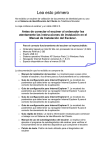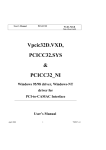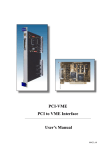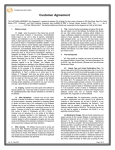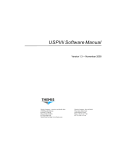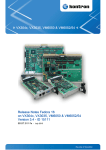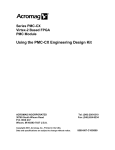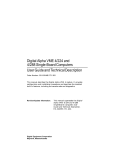Download 00437.A0 vpcivmed - W-IE-NE
Transcript
VPCIVMED
Windows 95 driver for
PCI-VME
User’s Manual
*00437.A0
General Remarks
The only purpose of this manual is a description of the product. It must not be interpreted a
declaration of conformity for this product including the product and software.
W-Ie-Ne-R revises this product and manual without notice. Differences of the description in
manual and product are possible.
W-Ie-Ne-R excludes completely any liability for loss of profits, loss of business, loss of use
or data, interrupt of business, or for indirect, special incidental, or consequential damages of
any kind, even if W-Ie-Ne-R has been advises of the possibility of such damages arising
from any defect or error in this manual or product.
Any use of the product which may influence health of human beings requires the express
written permission of W-Ie-Ne-R.
Products mentioned in this manual are mentioned for identification purposes only. Product
names appearing in this manual may or may not be registered trademarks or copyrights of
their respective companies.
No part of this product, including the product and the software may be reproduced,
transmitted, transcribed, stored in a retrieval system, or translated into any language in any
form by any means with the express written permission of W-Ie-Ne-R.
VPCIVMED is designed by ARW Elektronik, Germany
Kommentar [vH1]: Versionen
dieses Dokuments:
Wann
... [1]
January 13
i
*00437.A0
Table of contents:
1.
VPCIVMED driver: General description......................................................................... 1
2.
Installation........................................................................................................................ 2
3.
Operating the driver ......................................................................................................... 3
3.1.
A simple test unit: pvmon.exe.............................................................................. 3
3.2.
Using the driver for program code........................................................................... 3
3.3.
Services .................................................................................................................... 4
3.4.
Interrupt vectors ....................................................................................................... 6
APPENDIX A : Packing list:................................................................................................... 7
APPENDIX B : Short form manual of pvmon ........................................................................ 8
APPENDIX C : Header file vpcivmed.h ............................................................................... 10
APPENDIX D : Standard initialization procedure................................................................. 17
APPENDIX E : Standard deinitialization procedure ............................................................. 18
List of tables:
Table 1: Coding of interrupt level and vector. ......................................................................... 5
Table 2: Interrupt vectors for different sources. ...................................................................... 6
January 13
ii
*00437.A0
User’s Manual
VPCIVMED
W-Ie–Ne-R
Plein & Baus GmbH
1.
VPCIVMED driver: General description
VPCIVMED provides an easy access to the VME bus for Windows951 and 98 users. It’s
major efforts are demonstrated by a small test program pvmon.exe which is supplied in the
same package.
It is easy to use the driver for your own VME application. The driver is independent from the
chosen programming language since Windos95 standard I/O functions are used for the
communication.
VME access is performed via an interface window of an area of virtual memory which is
defined by the driver. For user applications this window looks like normal memory. Read
and write operations to the VME bus are converted into simple read and write operations into
the (not real) memory.
The access to the driver is not limited to one process. Multiple processes can use the driver.
Even one driver supports multiple VME interfaces.
Different levels of VME interrupts are handled by the interface. The driver provides several
serviced to operate these interrupts.
1
Windows95 and Windows98 are trademarks of the Microsoft Corporation.
January 13
1
*00437.A0
User’s Manual
VPCIVMED
W-Ie–Ne-R
Plein & Baus GmbH
2.
Installation
Be sure that PCIADA card of the PCI-VME interface is installed in your PC. Please refer to
the PCI-VME manual to insert the card.
After switching on you machine Windows recognizes the new hardware in you system and
asks for a driver. Insert the supplied CD into your drive and enter the driver’s path. If you
CDROM is drive D type D:\WIN95\DRIVER.
In the next step the driver is copied to WINDOWS\SYSTEM\VPCIVMED.VXD and the
interface is added to the WINDOWS registry. You will find the driver at
HKEY_LOCAL_MACHINE\ENUM\PCI\VEN10B5&DEV9050 ...
You will find the interface at start / settings / control panel / system
/ device manager where Interrupt and I/O settings can be verified.
Note:
The driver only works for Windows 95 / 98 in 32 bit mode. Only real 32 bit
applications can use the driver but it does not work for MS-DOS2 or WINDOWS
3.11 programs.
So far WINDOWS NT3 is not supported. A driver is under preparation.
2
MS-DOS and Windows 3.11 are trademarks of the Microsoft Corporation.
3
Windows NT is a trademark of the Microsoft Corporation.
January 13
2
*00437.A0
User’s Manual
VPCIVMED
W-Ie–Ne-R
Plein & Baus GmbH
3.
Operating the driver
3.1. A simple test unit: pvmon.exe
The program is a useful tool to check the access to the VME bus and test VME modules. It
expects the driver vpcivmed in C:\WINDOWS\SYSTEM. If it is not there the path has to be
specified.
Open a DOS box and start pvmon by typing pvmon -?. A short help is displayed. Help can
be obtained by typing ? on the prompt, too.
Before accessing the VME bus pvmon has to be configured by typing c. Store the settings
and restart the program. Now you can exchange data with the VME bus.
For more information please refer to the short form manual in APPENDIX B.
3.2. Using the driver for program code
Access to the driver is managed by Windows 95 Standard I/O functions which are
independent from the programming language. Header files for c++ programs are supplied
with the interface. They could easy adapted to other languages.
In your program include files vpcivmed.h and windows.h. Add winerror.h too if
you want to use GetLastError() to decode error messages. Use window’s function
CreateFile() to open the interface, DeviceIoControl() to operate it and
CloseHandle () to close it.
At
maximum
VPCIVMED_MAX_PCIADA
PCIADA
cards
(currently
4),
VPCIVMED_MAX_VMEMM interfaces (16) and VPCIVMED_MAX_WINDOWS (8) different
windows are supported by the driver. These parameters are defined in vpcivmed.h. Only
the number of the VMEMM module is used to identify different modules and cards.
Intercommunication between driver and the users program is done via memory windows.
The driver provides a window for each process who requested it returning a pointer into the
window.
Size, Address Modifier and offset to access the VME bus is fixed for each window. Random
access to different windows it possible. The driver itself takes care of Address Modifier and
address offsets.
Any PCI-VME application using the driver contains three major parts:
1. Startup
vxd_Handle = CreateFile(VxDpathName,0,0,NULL,0,
FILE_FLAG_DELETE_ON_CLOSE,NULL);
During this procedure number and IDs of connected VMEMM modules is determined.
2. Controlling the Interface Each access to the interface is done by
result = DeviceIoControl(vxd_Handle, .....);
It is only necessary to pass the ID of the selected VMEMM module to the driver. The
corresponding ID of the PCIADA card is calculated automatically.
3. Shut down On the command
CloseHandle(vxd_Handle);
the driver is closed for the application. It is removed of the memory after it’s last process
has finished.
January 13
3
*00437.A0
User’s Manual
VPCIVMED
W-Ie–Ne-R
Plein & Baus GmbH
3.3. Services
The driver provides different services which communicate via DeviceIoControl()with
the application. Numbers and structures for this communication are defined in
vpcivmed.h (see APPENDIX C). Define Pointers to in and out structures before calling
the driver.
A call of the driver may look like:
VPCIVMED_STANDARD_COMMAND sInterface;
VPCIVMED_VECTOR_LEVEL
sVectorLevel;
DWORD
DIOC_count;
DWORD
dwResult;
*
*
sInterface.dwInterface = 1;
// selection of 1st VMEMM
// poll if an interrupt is pending -----------------dwResult = DeviceIoControl(vxd_Handle, VPCIVMED_READ_VECTOR,
&sInterface, izeof(sInterface),&sVectorLevel,
sizeof(sVectorLevel), &DIOC_count, NULL);
if (!dwResult)
printf(„Error %d occured\n“, GetLastError());
else
printf(„I have read a vector %d at level %d\n“,
sVectorLevel.dwStatusID, wLevel);
*
*
Service VPCIVMED_READ_VECTOR is called. Pointers to in and out structure and it’s sizes
are necessary. An error code which is explained in winerror.h and the real size of the
returned data is returned.
Description of the defined services:
VPCIVMED_INIT_HARDWARE initializes one VMEMM module. Standard initialization
commands are summarized in APPENDIX D. Additional initialization commands can be
passed to the interface. All VPCIVMED_INIT_COMMANDs have to be stored in a STOP
terminated array. Example:
struct
{
DWORD dwInterface;
VPCIVMED_INIT_ELEMENT sVIC[3];
} sUserInitStruct = {0, {{VIC, BYTE_ACCESS,
0x57, 0xAA},
{VIC, BYTE_ACCESS,
0x53, 0x00},
{STOP, WORD_ACCESS, 0x00, 0x00}}};
Note: If the array contains only the STOP element the standard initialization will be
performed.
The interface will be initialized on the first call of the service. It has to be deinitialized
before a new initialization is possible.
VPCIVMED_DEINIT_HARDWARE deinitializes the specified VMEMM board and it’s
PCIADA card. Additional commands are added as described above. APPENDIX E shows
the standard commands.
VPCIVMED_ATTACH_WINDOW reserves a window for VME access. One process can open
VPCIVMED_MAX_WINDOWS at maximum. Parameters which are required to open a
window are passed in a VPCIVMED_ADD_WINDOW structure. The window size is limited
to 256 Mbyte.
January 13
4
*00437.A0
User’s Manual
W-Ie–Ne-R
VPCIVMED
Plein & Baus GmbH
Address Modifier, a Base Address and size have to be specified for each window. Only
values at the edge of a 4k page are possible for address and size. The driver’s header file
provides macro functions PAGE_BASE() and PAGE_SIZE() to calculate these
numbers.
The driver maps the specified area of the VME bus into the (virtual) memory. A pointer
to this memory region is returned. Each access to this region is mapped into the VME
bus. Any access out of the window will be denied.
Errors during VME bus access are not reported as Windows errors.
VPCIVMED_DETATCH_WINDOW releases a previously reserved window. Use a
VPCIVMED_REMOVE_WINDOW structure to define parameters.
VPCIVMED_GET_STATIC_STATUS returns status information of a VMEMM interface in
a VPCIVMED_STATIC_STATUS structure.
VPCIVMED_GET_DYNAMIC_STATUS informs about parameters of the interface which
change during operation. Use a VPCIVMED_DYNAMIC_STATUS structure for
communication.
VPCIVMED_READ_VECTOR
returns
VPCIVMED_VECTOR_LEVEL structure.
interrupt
information
in
a
VPCIVMED_ACCESS_VIC68A provides direct access to the VIC68A chip. Use a
VPCIVMED_VIC68A_ACTION structure to program the chip and for the exchange of
data.
The PCI-VME profits of the huge variety of features which are provided by the VIC68A
chip, e. g. direct access to 68xxx processors and programmable delays by accessing the
VIC68A directly. No limitations of this communication are installed.
Note: Do not change any registers which may influence the Address Modifier
Register. It will cause errors in the mechanism of interface windows.
VPCIVMED_INSTALL_IRQ_HANDLER installs the interrupt handler on the local interrupt
priority level. The TCB (Thread Control Block) of the calling thread is stored when the
service is accessed. If an interrupt is enabled and released and the thread is alertable it is
possible to invoke the installed interrupt handler.
Either PCIADA or VMEMM interrupts cause the interrupt handler. Interrupt source is
coded in a parameter which is described in Table 1.
Table 1: Coding of interrupt level and vector.
meaning
unused
interrupt level
unused
interrupt vector
bits
31 to 19
18 to 16
15 to 8
7 to 0
A BUS ERROR is handled as an VMEMM Interrupt. Since the driver is locked after each
VMEMM interrupt it has to be released by the user’s application. Interrupts caused by
PCIADA are treated as virtual level 8.
VPCIVMED_CONTROL_INTERRUPTS controls the interrupt mechanism. It enables or
disables specified interrupts of PCIADA or VMEMM.
VPCIVMED_TAS causes an uninterruptible cycle on the VME bus which is comparable to
the TAS command of 68xxx processors.
VPCIVMED_GET_PCIADA_STATUS returns status of all connected PCIADA boards
installed in the PC. It checks which VMEMM modules are connected and ready.
January 13
5
*00437.A0
User’s Manual
VPCIVMED
W-Ie–Ne-R
Plein & Baus GmbH
VPCIVMED_RESET controls different reset functions of the interface and the VME bus
which are a local reset, a global reset and a VME bus reset.
Contents of all VIC68A registers are lost during a reset. Perform a deinitialization and a
reinitialization after the reset to reload registers.
3.4. Interrupt vectors
Each interrupt caused by VMEMM has to be vectored. Normally vectors from 0x00 to 0x3F
are used by the driver (internal use) and vectors from 0x40 to 0xFF are reserved for VME
bus and it’s peripherals. Refer to Table 2 for detailed information.
Note:
The time out interrupt generated by PCIADA causes an interrupt vector number 1.
Table 2: Interrupt vectors for different sources.
Interrupt source
vector no.
Interrupt caused by PCIADA (time out)
1 (active)
Clock Tick Interrupt Generator
2
Reset push button on the front panel
6 (active)
VME bus Timeout (Bus-Error)
7 (active)
Interprocess communication global switch #0
8
Interprocess communication global switch #1
9
Interprocess communication global switch #2
10
Interprocess communication global switch #3
11
Interprocess communication module switch #0
12
Interprocess communication module switch #1
13
Interprocess communication module switch #2
14
Interprocess communication module switch #3
15
ACFAIL asserted
16
Write post Fail
17
Arbitration Timeout
18
SYSFAIL asserted
19
VME bus Interrupter acknowledge
20
Note:
Pressing the reset button on the front panel causes an interrupt. Applications have
to take care of any further action which should be performed.
Note:
If more than one application use one window of the interface it is not possible to
locate the cause of a VME BUS ERROR. In this case every only one action is
performed.
If errors occur during interrupt operations check at start / settings / control
panel / system / device manager if any interrupt reserved for the interface. The
interface works without a reserved interrupt but interrupt functions are not available in this
case.
January 13
6
*00437.A0
User’s Manual
VPCIVMED
W-Ie–Ne-R
Plein & Baus GmbH
APPENDIX A: Packing list:
The driver is delivered in one CD ROM which contains:
Directory WIN95\DRIVER:
vpcivmed.vxd
pcivme.inf
the driver
INF file for installation
Directory WIN95\DRIVER\SOURCE:
vpcivmed.h
vic.h
vme.h
header file to access the driver
header file for the VIC68A chip
header file to access the VME bus
source files for the driver
Directory WIN95\PVMON:
pvmon.exe
a useful program
Directory WIN95\PVMON\SOURCE:
source files for pvmon.
January 13
7
*00437.A0
User’s Manual
W-Ie–Ne-R
VPCIVMED
Plein & Baus GmbH
APPENDIX B: Short form manual of pvmon
pvmon is a simple shell program to test the PCI-VME interface by ARW Elektronik. The
code is OpenSource and is enclosed to the interface.
This program is free software; you can redistribute it and/or modify it under the terms of
the GPL as published by the FSF (version 2 or later).
Overview of pvmon commands (type “?” to get this help):
a[h] [adrmode]
: Change address modifiers, h=help
c
: Configure interface
d[m] [start] [end]
: Dump memory area
e[m] <start> [value]
: Examine or change memory area
f<m> <start> <end> <x>
: Fill memory from <start> til <end> with <x>
g<m> <st> <en> [l] [x]
: Generate random memory test. (loop l, seed x)
h
: This help
i
: Interface init
l[m]
: Get VME interrupt status/ID
m<m> <src> <end> <dest>
: Move memory area
o
: Jump to OS
p[adrmode]
: Port search
q
: Quit program
r[x] <f> <start> [end]
: Read file <f> to VME, x= x or s (HEX)
s[m] <start> <end> <p>
: Search pattern <p>=different Items
t <start>
: TAS emulation, 'Test and Set' bit 7
v
: Generate VME SYSRESET
w[x] <f> <start> <end>
: Write VME into file <f>, h=Intel Hex
x <start> [val]
: Read/Write to interface register @ start
y[1/0]
: Read/set/clear SYSFAIL
z[0..3]
: Show interface internals
m = mode, e.g. b=byte, w=word, l=long (double) word; h = help, x= hex
start(address), end(address), src=source, dest=destination, []=option
pvmon is available for WIN 95/NT and Linux. The driver for the operating system has to be
installed.
An error message is reported if no driver was found or the VME crate is not online.
The first time pvmon is started a configuration is mandatory. Simply type c on the command
line.
January 13
8
*00437.A0
User’s Manual
VPCIVMED
W-Ie–Ne-R
Plein & Baus GmbH
Powerful commands are implemented in pvmon. Try p to look for ports or test the RAM on
the VME bus with the command:
gw 0 10000 40.
In the address range from 0x00000 to 0x10000 RAM is tested for the predetermined address
modifier in 0x40 runs using a random pattern.
Note:
Before using the command make sure that no important data is stored in the
address range. All addresses will be overwritten.
To use pvmon interactively type e. g.
pvmon a39/p/a29/p
First address modifier is set to 0x39 and the address range is scanned readable addresses.
The same is repeated for AM = 0x29.
January 13
9
*00437.A0
User’s Manual
VPCIVMED
W-Ie–Ne-R
Plein & Baus GmbH
APPENDIX C: Header file vpcivmed.h
#ifndef __PCIVMEH_H__
//--------------------------------------------------------------------------------------// PCIVMEH.H, shared between applications and VPCIVMED driver
//
// (c) 1999 ARW Elektronik
//
// this source code is published under GPL (Open Source). You can
use, redistribute and
// modify it unless this header
is not modified or deleted. No
warranty is given that
// this software will work like expected.
// This product is not authorized for use as critical component in
life support systems
// without the express written approval of ARW Elektronik Germany.
//
// Please announce changes and hints to ARW Elektronik
//
// What
Who When
// first steps
AR
24.01.98
// added direct read write access to vic68a chip registers
AR
12.07.98
// rename PCR_* into LCR_*
AR
19.07.98
// TAS included
AR
17.02.99
// Corrections about interrupt handling
AR
20.02.99
// changes about PCIADA status
AR
25.02.99
// changes of IOCTL codes because of compatibility to WIN NT
AR
12.03.99
// PLX 9052 removed out of VPCIVMED_STATIC_STRUCT
AR
16.03.99
// VIC68A_WRITE_ONLY added
AR
17.03.99
// extension for VME reset
AR
18.04.99
// release of version 2.5 for driver
AR
18.04.99
//
//--------------------------------------------------------------------------------------// constants to be used to access certain features of the PCIVME
interface
//
#define VPCIVMED_CTL_CODE(x)
(0x80002000 | (x << 2)) //
compatibility to WIN-NT
#define VPCIVMED_INIT_HARDWARE
(VPCIVMED_CTL_CODE( 0)) //
initializes the hardware with given parameters
#define VPCIVMED_DEINIT_HARDWARE
(VPCIVMED_CTL_CODE( 1)) //
uninitializes the hardware
#define VPCIVMED_ATTACH_WINDOW
(VPCIVMED_CTL_CODE( 2)) //
requests a base address to a vme window
January 13
10
*00437.A0
User’s Manual
VPCIVMED
W-Ie–Ne-R
Plein & Baus GmbH
#define VPCIVMED_DETACH_WINDOW
frees a vme window
#define VPCIVMED_GET_STATIC_STATUS
for INTERFACE structure
#define VPCIVMED_GET_DYNAMIC_STATUS
for dynamic status
#define VPCIVMED_READ_VECTOR
reads the level and vector of IRQ
#define VPCIVMED_ACCESS_VIC68A
access vic68a register
#define VPCIVMED_INSTALL_IRQ_HANDLER
installs a handler function
#define VPCIVMED_CONTROL_INTERRUPTS
enable, disable of interrupts
#define VPCIVMED_TAS
test and set
#define VPCIVMED_GET_PCIADA_STATUS
the status of PCIADA(s) only
#define VPCIVMED_RESET
a reset to VME or global
(VPCIVMED_CTL_CODE( 3)) //
(VPCIVMED_CTL_CODE( 4)) // asks
(VPCIVMED_CTL_CODE( 5)) // asks
(VPCIVMED_CTL_CODE( 6)) //
(VPCIVMED_CTL_CODE( 7)) //
(VPCIVMED_CTL_CODE( 8)) //
(VPCIVMED_CTL_CODE( 9)) //
(VPCIVMED_CTL_CODE(10)) // make
(VPCIVMED_CTL_CODE(11)) // get
(VPCIVMED_CTL_CODE(12)) // make
//--------------------------------------------------------------------------------------// possible return codes
//
#define BOGUSADDRESS 0xffffffff
// Returned by MS routines
//--------------------------------------------------------------------------------------// some built in limits
//
#define VPCIVMED_MAX_PCIADA
4 // maximum count of supported PCI
interfaces
#define VPCIVMED_MAX_VMEMM
16 // maximum number of supported
VMEMMs
#define VPCIVMED_MAX_WINDOWS
8 // maximum number of windows into
VME
//--------------------------------------------------------------------------------------// switches and masks
//
// switches for VPCIVMED_INIT_COMMANDs -------------------------#define LCR
(BYTE)0
// destination is LCR register
#define IFR
(BYTE)1
// destination is VME-Interface register
#define VIC
(BYTE)2
// destination is VIC68A register
#define STOP (BYTE)255 // this command stops the init machine
#define BYTE_ACCESS (BYTE)1
#define WORD_ACCESS (BYTE)2
#define LONG_ACCESS (BYTE)4
// write byte wise
//
word
//
long
// switches for VPCIVMED_ACCESS_VIC68A -------------------------#define VIC68A_READ
0
// read only access
#define VIC68A_WRITE
1
// write and read back access
#define VIC68A_OR
2
// read, bit wise 'or' content and
read back access
#define VIC68A_AND
3
// read, bit wise 'and' content and
read back access
#define VIC68A_WRITE_ONLY 4
// do not read back after write
January 13
11
*00437.A0
User’s Manual
VPCIVMED
W-Ie–Ne-R
Plein & Baus GmbH
// switches for VPCIVMED_VECTOR_CMD ----------------------------#define READ_CURRENT_LEVEL 0
// try to get the current IRQ level
#define READ_VECTOR
1
// (if level == 0) read vector @
current LEVEL else @ level
// switches for the VPCIVMED_RESET -----------------------------#define VME_RESET_CMD
0
// raise a VME reset only
#define LOCAL_RESET_CMD
1
// raise a local reset only
#define GLOBAL_RESET_CMD
2
// raise a global reset
#define POLL_RESET_CMD
3
// ask if reset is finished
// address masks for the pager - to use for offset and size
alignment ----------#define HI_ADDRESS_MASK
(DWORD)0xFFFFF000
// masks the
part of a vme address
#define LO_ADDRESS_MASK
(~HI_ADDRESS_MASK)
// masks the
part of a vme address
#define ONE_PAGE_SIZE
(LO_ADDRESS_MASK + 1) // size of
(hardware related)
@ window
high
low
1 page
// macros to calculate the real base and the real size of demand
pages ------------------#define PAGE_BASE(base)
(base & HI_ADDRESS_MASK) // makes an
aligned base for a page
#define PAGE_SIZE(base, size) (((base + size + LO_ADDRESS_MASK) /
ONE_PAGE_SIZE) * ONE_PAGE_SIZE)
//--------------------------------------------------------------------------------------// ERROR RETURNS in dIfcStatus
//
#define E_NO_ERROR
0
// all OK
#define E_INCOMPATIBLE
1
// incompatible hardware
#define E_NO_ADDRESS
2
// cant get lcr or ifr addresses
#define E_NOT_CONNECTED
3
// no VMEMM hardware connected
#define E_CON_ERROR
4
// data transfer failure
#define E_EMPTY
-1 // no PCI interface associated
//--------------------------------------------------------------------------------------// shared structures between PCIVME-IF and Application - COMMANDS
//
typedef struct
{
DWORD dwInterface;
// some command only need this input
into requests
} VPCIVMED_STANDARD_COMMAND;
typedef struct
interface or deinitialize
{
BYTE
range;
stop, default = vme-if
BYTE
type;
= dword access, default byte
WORD
offset;
for initialisation
DWORD
value;
} VPCIVMED_INIT_ELEMENT;
January 13
// one command element to initialize
// 0 = lcr, 1 = vme-interface, -1 =
// 1 = byte access, 2 = word access, 4
// offset into interface address range
// value to initialize
12
*00437.A0
User’s Manual
VPCIVMED
W-Ie–Ne-R
Plein & Baus GmbH
typedef struct
{
DWORD
dwInterface;
// targets to interface number
VPCIVMED_INIT_ELEMENT sVie[1]; // at least one zero element must
be the last
} VPCIVMED_INIT_COMMAND;
typedef struct
{
DWORD
dwInterface;
//
DWORD
base;
//
(base + size) must be less than
DWORD
size;
//
std, 64k for short
WORD
modifier;
//
window
} VPCIVMED_ADD_WINDOW;
typedef struct
{
DWORD dwInterface;
DWORD *pdwLinAdr;
} VPCIVMED_REMOVE_WINDOW;
typedef struct
{
DWORD
dwInterface;
DWORD
dwAddress;
WORD
wModifier;
window
BYTE
bContent;
} VPCIVMED_TAS_STRUCT;
typedef struct
{
DWORD dwInterface;
WORD wRegisterAddress;
WORD wAccessMode;
BYTE bContent;
} VPCIVMED_VIC68A_ACTION;
typedef struct
{
DWORD dwInterface;
...
DWORD dwIrqHandler;
Handler
} VPCIVMED_IRQ_HANDLER;
typedef struct
{
DWORD dwInterface;
...
WORD wEnable;
} VPCIVMED_IRQ_CONTROL;
typedef struct
{
DWORD dwInterface;
WORD wAction;
vector @ level
January 13
targets to interface number ...
offset into VME address range.
128 Mbytes for ext, 16 Mbytes for
VME address modifier for this
// targets to interface number ...
// linear address of window to remove
// targets to interface number ...
// tas to address
// VME address modifier for this
// byte content to store and get back
//
//
//
//
targets to interface number ...
address offset of vic68a register
read, write, or, and
content to write, and, or
// targets to the interface number
// void (*IrqHandler)(DWORD) = User
// BOGUSADDRESS deinstalled
// targets to the interface number
// a 1 enables, a 0 disables
// targets to interface number ...
// read current irq level, read
13
*00437.A0
User’s Manual
VPCIVMED
W-Ie–Ne-R
Plein & Baus GmbH
WORD wType;
} VPCIVMED_VECTOR_COMMAND;
typedef struct
{
DWORD dwInterface;
WORD wCommand;
} VPCIVMED_RESET_COMMAND;
// must be set to 1
// targets to interface number ...
//--------------------------------------------------------------------------------------// shared structures between PCIVME-IF and Application - RESPONSE
//
// includes static information about driver parameters -----typedef struct
// caution: very sensitive on
alignment
{
DWORD dwInterface;
// comes from the interface No.
DWORD dIfcStatus;
// usable ? fits to driver? OK?
DWORD dwLinkCount;
// how often this interface is
requested
WORD
WORD
WORD
WORD
wNumMemWindows;
wNumIOPorts;
wNumIRQs;
wNumDMAs;
// from actual configuration
DWORD dLCR_MemBase;
DWORD dLCR_MemLength;
// from actual configuration
WORD
WORD
WORD
WORD
wLCR_IOBase;
wLCR_IOLength;
wLCR_IRQ;
wReserve1;
DWORD dUSR_MemBase;
DWORD dUSR_MemLength;
WORD
WORD
WORD
WORD
wModuleType;
wFPGAVersion;
wModuleNumber;
wWordMode;
WORD
WORD
wSysControl;
wConnected;
PVOID pvLcr;
PVOID pvIfr;
WORD *pwCSR;
WORD *pwIRQStat;
BYTE *pbVector;
DWORD *pdwVMEAdr;
BYTE *pbModifier;
register
void *pvVME;
DWORD dwPagePhysVME;
window
January 13
// read from connected hardware
// virtual address of LCR
// virtual address of IFR
//
//
//
//
//
//
some addresses to tune performance
pointer to csr register
pointer to irq status
pointer to vector read register
pointer to VME address register
pointer to address modifier
// pointer into VME window
// physical page number of the VME
14
*00437.A0
User’s Manual
VPCIVMED
W-Ie–Ne-R
Plein & Baus GmbH
void *psIrqDescriptor;
descriptor
DWORD dwActivePage;
interface
WORD
// pointer to associated irq
// the current active page of this
wReserve2;
char cszHWRevision[10];
} VPCIVMED_STATIC_STATUS;
typedef struct
{
DWORD dwInterface;
WORD wVMEMM_connected;
powered
WORD wVMEMM_enable;
WORD wPCIADAIrq;
WORD wVMEMMIrq;
} VPCIVMED_DYNAMIC_STATUS;
typedef struct
{
DWORD dwInterface;
DWORD dwStatusID;
WORD wLevel;
WORD wPCIIrq;
cleared
} VPCIVMED_VECTOR_LEVEL;
typedef struct
{
DWORD dwDummy;
WORD wVersion;
WORD wNumberOfInterfaces;
struct
{
DWORD dIfcStatus;
DWORD dwLinkCount;
requested
// comes from the interface No.
// status: VMEMM is connected and
// status: VMEMM access is enabled
// status: PCIADA timeout IRQ pending
// status: VMEMM IRQ pending
// comes from the interface No.
// interrupt-vector (byte, word, long)
// interrupt-level
// pending PCIADA Irq detected and
// nothing useful in here
// Version of driver
// number of detected PCIADA
// connection status of PCIADA-VMEMM
// how often this interface is
WORD
module
WORD
WORD
VMEMM
WORD
wModuleType;
// if connected: type of connected
wFPGAVersion;
wModuleNumber;
// if connected: Version of VMEMM FPGA
// if connected: Number of Connected
wWordMode;
// if connected: Mode of operation
WORD
WORD
wSysControl;
wConnected;
// if connected: VMEMM sysctl status
// connected or not
WORD wDummy;
char cszHWRevision[10]; // revision of PCI interface
} sPCIAda[VPCIVMED_MAX_PCIADA]; // status of each one
} VPCIVMED_PCIADA_STATUS;
typedef struct
{
DWORD dwInterface;
WORD wResult;
January 13
// targets to interface number ...
15
*00437.A0
User’s Manual
VPCIVMED
W-Ie–Ne-R
Plein & Baus GmbH
} VPCIVMED_RESET_RESULT;
(wResult != 0)
// polling result: in progress if
#define __PCIVMEH_H__
#endif
January 13
16
*00437.A0
User’s Manual
W-Ie–Ne-R
VPCIVMED
Plein & Baus GmbH
APPENDIX D: Standard initialization procedure
The standard initialization procedure is summarized in the following array:
{LCR, WORD_ACCESS, 0x4c, 0x0009}
interrupts
{LCR, WORD_ACCESS, 0x50, 0x4180}
interface
// disable
// enable
{VIC,
BYTE_ACCESS, (WORD)0x03, 0xf8+1}
// VIICR
{VIC,
{VIC,
{VIC,
{VIC,
{VIC,
{VIC,
{VIC,
BYTE_ACCESS,
BYTE_ACCESS,
BYTE_ACCESS,
BYTE_ACCESS,
BYTE_ACCESS,
BYTE_ACCESS,
BYTE_ACCESS,
// VICR1
{VIC,
BYTE_ACCESS, (WORD)0x23, 0xf8+0}
// DSICR
{VIC,
{VIC,
{VIC,
{VIC,
{VIC,
{VIC,
{VIC,
BYTE_ACCESS,
BYTE_ACCESS,
BYTE_ACCESS,
BYTE_ACCESS,
BYTE_ACCESS,
BYTE_ACCESS,
BYTE_ACCESS,
// LICR1
{VIC,
{VIC,
BYTE_ACCESS, (WORD)0x43, 0xf8+2}
BYTE_ACCESS, (WORD)0x47, 0xf8+3}
// ICGS
// ICMS
{VIC,
BYTE_ACCESS, (WORD)0x4b, 0xe8+6}
// EGICR
{VIC,
{VIC,
BYTE_ACCESS, (WORD)0x4f, 0x08}
BYTE_ACCESS, (WORD)0x53, 0x0c}
{VIC,
BYTE_ACCESS, (WORD)0x57, 0x00}
// LIVBR (!)
{VIC,
BYTE_ACCESS, (WORD)0x5b, 0x10}
// EGIVBR (!)
{VIC,
BYTE_ACCESS, (WORD)0x5f, 0x00}
// ICSR
{VIC,
{VIC,
{VIC,
{VIC,
{VIC,
BYTE_ACCESS,
BYTE_ACCESS,
BYTE_ACCESS,
BYTE_ACCESS,
BYTE_ACCESS,
{VIC,
BYTE_ACCESS, (WORD)0x83, 0xfe}
// VIRSR
{VIC,
{VIC,
{VIC,
{VIC,
{VIC,
{VIC,
{VIC,
BYTE_ACCESS,
BYTE_ACCESS,
BYTE_ACCESS,
BYTE_ACCESS,
BYTE_ACCESS,
BYTE_ACCESS,
BYTE_ACCESS,
// VIVR1
{VIC,
BYTE_ACCESS, (WORD)0xa3, 0x3c}
January 13
(WORD)0x07,
(WORD)0x0b,
(WORD)0x0f,
(WORD)0x13,
(WORD)0x17,
(WORD)0x1b,
(WORD)0x1f,
(WORD)0x27,
(WORD)0x2b,
(WORD)0x2f,
(WORD)0x33,
(WORD)0x37,
(WORD)0x3b,
(WORD)0x3f,
(WORD)0x63,
(WORD)0x67,
(WORD)0x6b,
(WORD)0x6f,
(WORD)0x73,
(WORD)0x87,
(WORD)0x8b,
(WORD)0x8f,
(WORD)0x93,
(WORD)0x97,
(WORD)0x9b,
(WORD)0x9f,
0x78+1}
0x78+2}
0x78+3}
0x78+4}
0x78+5}
0x78+6}
0x78+7}
0xf8+1}
0xf8+2}
0xf8+3}
0xf8+4}
0xf8+5}
0x38+6}
0x38+7}
0x00}
0x00}
0x00}
0x00}
0x00}
0x0f}
0x0f}
0x0f}
0x0f}
0x0f}
0x0f}
0x0f}
17
// VICR7
// LICR7
// ICGS-IVBR (!)
// ICMS-IVBR (!)
// ICR0
// ICR4
// VIVR7
// TTR
- 16 usec
*00437.A0
User’s Manual
VPCIVMED
W-Ie–Ne-R
Plein & Baus GmbH
{VIC,
{VIC,
{VIC,
BYTE_ACCESS, (WORD)0xb3, 0x40}
BYTE_ACCESS, (WORD)0xb7, 0x29}
BYTE_ACCESS, (WORD)0xd3, 0x00}
{IFR,
{IFR,
LONG_ACCESS, (WORD)ADRHL, 0xF0F0F0F0}
// ADR-H, ADR-L
WORD_ACCESS, (WORD)CSR , 0x0000} // Contr-Reg
{VIC,
BYTE_ACCESS, (WORD)0x7f, 0x80}
{LCR, WORD_ACCESS, 0x4c, 0x0009}
interrupts
{STOP, WORD_ACCESS, 0,
// ARCR
// AMSR
// RCR
// ICR7
// disable
0}
APPENDIX E: Standard deinitialization procedure
Deinitialization is divided into two part. Part one is run before the user deinitialization:
{VIC, BYTE_ACCESS, (WORD)0x7f, 0x00},
SYSFAIL
{LCR, WORD_ACCESS, 0x4c, 0x0009},
interrupts
{STOP, WORD_ACCESS, 0,
0}};
// ICR7 - set
// disable
Part two starts after the user commands:
{LCR, WORD_ACCESS, 0x50, 0x4080},
interface
{STOP, WORD_ACCESS, 0,
0}};
January 13
18
// disable
*00437.A0
Seite i: [1] Kommentar [vH1]
Dr. Lüder von Horn
Versionen dieses Dokuments:
Wann
Was
Wer
8. Juli 99
Manual erstellt
L. von Horn
19. Juli 99
Änderungen von K. Hitschler berücksichtigt L. von Horn
(vergl. vpcivmed-hitschler.doc)























